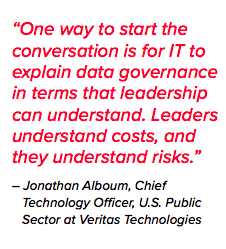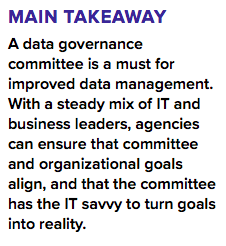This article is an excerpt from GovLoop’s recent guide, “Making IT Work: A Practical Guide to Modernization in Government.” Download the full guide here.
In the digital age, government agencies are producing and consuming unfathomable amounts and types of data. Lacking proper visibility, most of the information remains unorganized and therefore inaccessible.
In a recent interview with GovLoop, Jonathan Alboum, Chief Technology Officer, U.S. Public Sector at Veritas Technologies, and Kurt Steege, Chief Technology Officer at ThunderCat Technology, discussed the challenges associated with ever-increasing data and how a data governance strategy can help.
“The amount of data out there is expanding at a frightening rate, and it continues to grow exponentially,” Steege said. In addition to its sheer size, unorganized data poses several other risks to government. 
For one, unwieldy data storage patterns increase upfront costs — costs that can be eliminated if the data is disposed of when obsolete or unnecessary. Furthermore, that same data proves costly down the road if organizations need to spend countless man-hours retrieving what they already have to fulfill a Freedom of Information Act (FOIA) request or complete an archival project. Lastly, organizations with poor data visibility can lose track of sensitive information, lacking the policies or access credentials to protect and account for it.
Given new technological capabilities, it doesn’t have to be this way, and that’s where data governance comes in. A data governance strategy puts the policies into place to take stock of data, standardize reporting, implement security procedures and discover potential use cases.
“One way to start the conversation is for IT to explain data governance in terms that leadership can understand,” Alboum said. “Leaders understand costs, and they understand risks.” Once leaders understand the relationship between these drivers and data governance, a top-down enthusiasm can be suffused throughout an organization.
A data governance committee is another must for improved data management. With a steady mix of IT and business leaders, agencies can ensure that committee and organizational goals align, and that the committee has the IT savvy to turn goals into reality.
Fortunately, industry partners, like Veritas and ThunderCat, can help. Veritas and ThunderCat can make backup and recovery easy, all the while preparing agencies for the next wave of data privacy. Using the Veritas 360 Data Management Suite, agencies can leverage a single solution to visualize, protect, access and migrate their data across diverse technological environments – without hardware or cloud vendor lock-in. 
Although managing data can seem like an uphill struggle – because of its sheer size and unfamiliarity – the first step is accounting for what you have. With the right data management solutions, organizations can turn data from a morass of indecipherable zeroes and ones into important, usable assets that open new windows for mission growth.
Photo Credit: Rawpixel via Unsplash






Sounds like data governance is a great step for agencies who are struggling with a lack of visibility into their data. Thanks for posting Isaac!